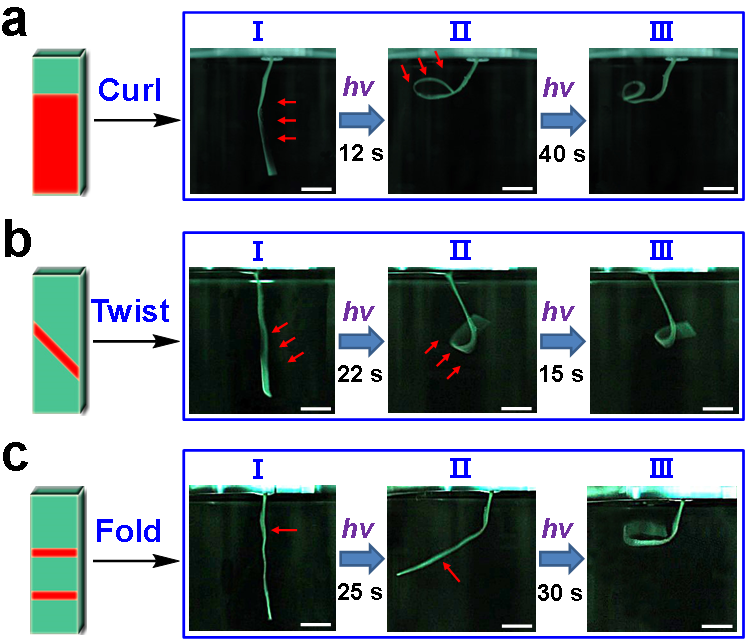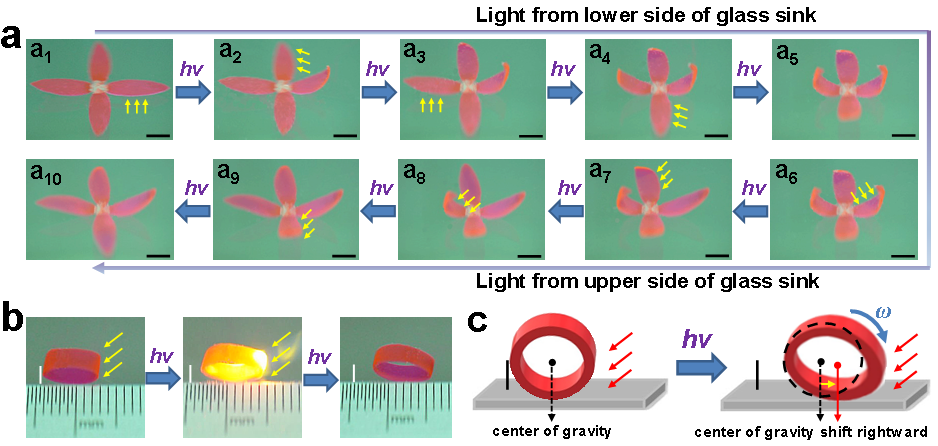Hydrogels are ideal candidates for flexible actuators owing to their biocompatibility and physiochemical characteristics analogous to biological soft tissues. Smart hydrogel actuators can change their original shapes upon the trigger of external stimuli (such as temperature, light and magnetic field). Photo-driven hydrogel actuators have attracted wide attention by their underwater photomechanical applications. However, there are still limitations for photo-driven hydrogel actuator materials, including dependence on harmful ultraviolet rays, slow driving speed and finite deformation ability. The incorporation of molecular photoswitches with fast photochemical response in hydrogel polymer materials is expected to solve the above problems.
Recently, Zhu et al, from Wuhan National Laboratory for Optoelectronics, Huazhong University of Science and Technology, designed and synthesized a kind of polyurethane (PU) hydrogel with dual cross-linking structure using hexaarylbiimidazole (HABI) as dynamic crosslinking agent and pentaerythritol as fixed crosslinking agent (Figure 1b). Under illumination, the dynamic C-N covalent bonds in HABI units were dissociated (Figure 1a), the total cross-linking density of the material decreased, and thereby the photo-induced swelling behavior of the material occurred (Figure 1c). The static pentaerythritol crosslinking network gives recovery capability and keeps the material with excellent reusability.

Figure 1. Molecular design and anisotropic deformation mechanism of PU hydrogel: (a) The reversible cleavage of the dynamic C-N covalent bond in HABI molecule at room temperature; (b) The monomers used in the synthesis of PU hydrogel; (c) The anisotropic bending mechanism of PU hydrogel under water.
The PU hydrogel with 0.2 mm thickness showed a variety of anisotropic transformations upon 405 nm light irradiation. By changing the irradiation mode of incident light, in just a few tens of seconds, the material can achieve complex three-dimensional (3D) deformations underwater, such as crimping, twisting and folding (Figure 2).

Figure 2. The underwater diversified three-dimensional deformations of hydrogel with 0.2 mm thickness: (a) light-controlled crimping; (b) light-controlled distorting; (c) light-controlled folding. The red area in the model on the left represents the scanning area of incident light on the right side of the material.
In addition, they fabricated a bionic flower by the PU hydrogel materials, which can open and close under the light irradiation from different sides. At the same time, the hydrogel wheel made of the PU hydrogel material can realize fast light-driven movement.

Figure 3. Bionic photo-actuations of PU hydrogel : (a) Photo-driven blooming and closing of bionic flower; (b) Photo-induced movement of hydrogel wheel; (c) Mechanism diagram of the light-controlled movement of hydrogel wheel.
In this work, the HABI unit with fast photochemical response was incorporated into the hydrogel polymer network, which offers a solution for the limitations of slow driving speed and limited deformation ability of hydrogel materials. At the same time, dual covalent cross-linking network endows the materials with excellent mechanical properties, which promotes the application of hydrogel materials in the fields of bionic movement, biosensor and flexible robot.
The above work was published on Nano Energy (Nano Energy. 2021, 85, 105965. full text website: https://doi.org/10.1016/j.nanoen.2021.105965). The authors are Shi-Li Xiang, Yu-Xuan Su, Hong Yin, Chong Li and Ming-Qiang Zhu.
Zhu and Li’ group developed the concept of photoplastic and published a few original works in the field of photoresponsive smart polymers based on HABI. They have applied HABI to the photo-induced solid-liquid conversion of polymer materials [ACS Appl. Mater. Interfaces, 2019, 11, 23623], photo-induced self-healing [Mater. Chem. Front., 2021, 5, 1364], photoplastic elastomer [Chem. Mater., 2019, 31, 5081] and photomechanical hydrogels [Nano Energy. 2021, 85, 105965]. They were recently invited to review the progress of photochromic molecules based photomechanical hydrogels (Figure 4) (J. Poly. Sci, 2021, 59, 2246. Full text website: https://doi.org/10.1002/pol.20210567).

Figure 4. The photochromic molecules and the schematic diagram of photo-driven deformation.
Written by: Li Chong
Reviewed by: Dong Jianji, Gou Bingbing